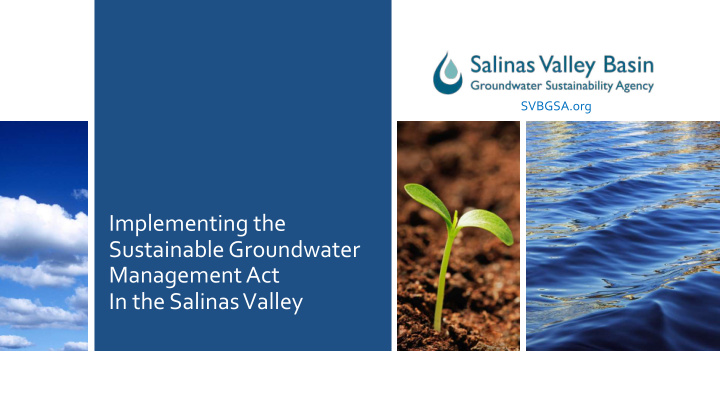



SVBGSA.org Implementing the Sustainable Groundwater Management Act In the Salinas Valley
2011-2017 2011-2017
Who Does SGMA Apply To? • There are 515 groundwater basins in the State • SGMA applies to the 127 “high and medium priority” basins • 21 basins are critically-over drafted • Parts of Salinas Valley • Santa Cruz Mid-County • Pajaro Valley
Salinas Valley Basin Groundwater Sustainability Agency • Formed as a Joint Powers Authority • Board Representation • Monterey County • Agriculture • Monterey One-Water • Forebay • Eastside/Langley • Monterey County Water Resources • Pressure 180-400 Agency • Upper Valley • Castroville Community Service District • CPUC Regulated Water Company • Cities • Environmental • King City • Disadvantaged Community/ Small Public • Soledad Water Systems • Gonzales • Other Eligible GSA Entity • Salinas • Contract Agency • City of Salinas • No full time employees • South County Cities • No legacy costs • Public Member • Regional Government Services 5 9/30/19 Add a footer
Guiding Principles • Understanding where people are and what they want will direct our actions • Inclusion and diversity produce better results • Doing it together is the right, though difficult, thing to do. 7 9/30/19 Add a footer
Public Meetings 2018-19 Total Governance Meetings 83 Total Public Info Meetings 35 23 5 Board Fee 24 Advisory 4 Boundary 14 Finance 7 GSP 8 Planning 19 Outreach 14 Executive Number of Meetings 128
Fee Approved March 14, 2019 Calculated Fee Schedule for Fiscal Year 2019/20 Proposition 26 Regulatory fee Sustainable Annual Fee Water Usage Groundwater FY 2019/20 Beneficiary Agricultural $4.79 Per Irrigated Acre 90% All Other $2.26 Per Service 10% Connection Per Irrigated Acre State of California Cost $110 Row Crop $93.50 Berries Per Irrigated Acre Estimated Domestic Water Usage Per Connection .36 acre foot (approximately 117K) gals)
SGMA Timeline SGMA Start Basin Modification GSA Formation GSP Development Jan 1, 2015 2016 2017 2018 – Jan, 31 2020 (or 2022) 2020 – 2040 Achieve Sustainability within 20 years 2040 – 2070 Maintain Sustainability for next 30 years
All the Data In Between 11 9/30/19 Add a footer
12 9/30/19 Add a footer
13 9/30/19 Add a footer
14 9/30/19 Add a footer
15 9/30/19 Add a footer
16 Chapter 9 Projects and Actions Addressing the Issues
Important Points • This chapter is our proposal on how to reach sustainability. Modifications will be made over the next three to five years • Not all projects and actions will need to be implemented • Many details need to be developed • Developed over first two to three years of implementation • Informed by other GSPs as they are written • Opportunity for more input • Demonstrate to DWR that we have the tools to reach sustainability 17
Project Assumptions ¨ Projects are designed to attain sustainability with existing water supplies ¨ Additional water supplies can be incorporated during early GSP implementation • Interlake tunnel • Jarrett Dam • Additional water supplies will trigger a reassessment of which projects to implement • Limited time to confirm new water supplies 18
19 Priority Projects
Invasive Species Eradication • Work with existing programs • Multiple benefits • Direct groundwater benefit to 180/400-Foot Aquifer Subbasin is limited • Indirect benefit through better river management, potential direct benefit in Southern Subbasin 20
CSIP Projects • Four individual projects identified • Optimize CSIP • Upgrade M1W plant for winter flows • Maximize CSIP use of existing SRDF diversion • Expand CSIP area • All projects work together – no one project is sufficient 21
Seawater Extraction Barrier • Designed to halt and reverse seawater intrusion • Relatively high cost, but a definitive fix • State of extracted water TBD • Optional injection barrier addressed 22
11043 Water Right • Divert using radial collectors • Project 1: radial collector at Chualar provides water to eastern Salinas area • Project 2: radial collector at Soledad provides water to southern Eastside Subbasin • Although this is a priority project, not all parts may be built • Many details still to be worked out. 23
Inject Winter Flows from SRDF • Extract at SRDF • Injection wells add water to 180-Foot and 400-Foot- Aquifers • Likely require a change in time of diversion on an existing water right • May reduce size, or need for, seawater intrusion barrier 24
25 Alternative Projects
Alternative Projects • Serve desalinated water to municipalities • Recharge local runoff from Gabilan Range • Recharge winter M1W advanced treated water if available • Conjunctive use of southern 180-Foot Aquifer 26
27 Management Actions
Management Actions • Outreach and Education • Best practices • Reservoir reoperation • Reliant on HCP • SVBGSA supports particular purposes for reservoir reoperation • Agricultural retirement • Only applicable to willing sellers • Potential to subsidize rotational fallowing or partial fallowing 28
Management Actions • Restrict pumping in CSIP area • Implemented after the CSIP projects are developed • Support extension of emergency ordinance in Deep Aquifer • Avoid too many wells in deep aquifer • Avoid severe water restrictions • Temporary until the Deep Aquifer study is complete 29
30 Water Charges Framework
Water Charges Framework • System to fund projects and actions • Provide a financial incentive to control pumping • Allow individual well owners, including municipalities, to make financial decisions on water use. • Identical framework in each Subbasin, but different details in each Subbasin • Other options will be reviewed, including regulatory fees, per acre charges 31
Water Charges Framework • Tiered system based on extraction • Tiers are unique in each Subbasin • Charges are unique in each Subbasin • Tradeable allowances (to some degree) • Rollover This will be a negotiated framework. Desired outcome is an equitable and agreed to system. 32
Recommend
More recommend